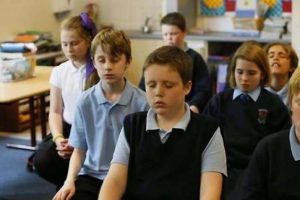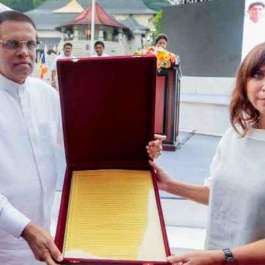
According to the Sri Lankan epic poem the Mahavamsa, or Great Chronicle, the Buddha knew of the island at the southeast tip of India, and foresaw that it was destined to be a great Buddhist center, making a total of three visits there. Written in the fifth or sixth century CE—a millennium after the life of the Buddha—this legend is unlikely to be true, but it seems likely that the Buddha’s teachings were brought to Sri Lanka around the third century BCE. For most of the island’s history, Buddhism has been the principal religion, and today more than 70 per cent of the island’s 21 million people are Theravada Buddhists, and over 6,000 monasteries accommodate some 15,000 monks.
Not surprisingly, the island has also been home to a significant amount of spectacular Buddhist imagery, from the 12th century monumental stone figures of the seated and reclining Buddhas at Polonnaruwa, to smaller statues made for individual worship. The Los Angeles County Museum of Art (LACMA) has in its collection several fine works of Sri Lankan Buddhist sculpture, and several are currently on display until 23 June as part of a larger exhibition of Sri Lankan art titled The Jeweled Isle: Art from Sri Lanka. Three Buddha figures from the 18th century, created in three very different materials, demonstrate the diverse artistic range within Sri Lankan Buddhist imagery during the Kandy period (1594–1815), during which Buddhism enjoyed significant royal patronage.
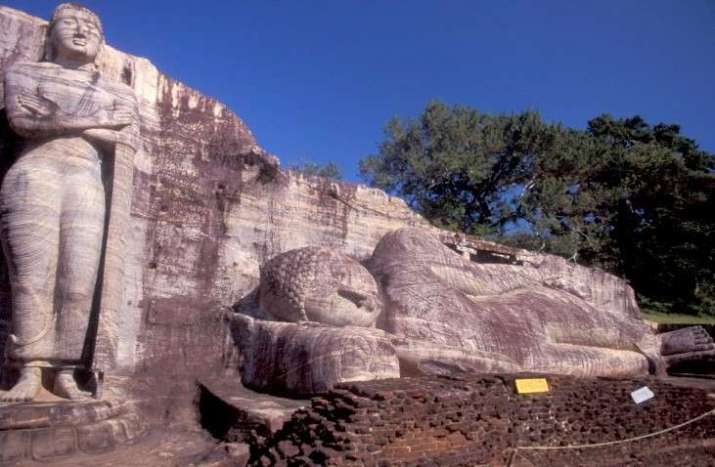
Arguably the most spiritually powerful Sri Lankan Buddhist sculpture in the LACMA collection is a gilt-copper figure of Shakyamuni Buddha seated with his hands on his lap in a gesture of meditation. Although the figure is only 42 centimeters high, it has a monumental quality, the square shoulders and perfectly balanced composition giving it an air of both serenity and solidity. As with most meditating Buddha images, he sits astride a throne of lotuses and wears the simple robes of a monk. Here the gossamer-thin robe almost adheres to his torso like a second skin, decorated with exquisite wave-like lines that give the robe a delicate pattern and texture. The elegant composition is topped by the flaming ushnisha (a cranial protuberance that symbolizes the Buddha’s advanced spiritual state). The flame shape is a distinctive southern Indian feature that spread from India to Sri Lanka, Myanmar, and then Thailand. Atop a figure who gleams golden in his meditative state, the flame completes this sculptural representation of the state of spiritual enlightenment.
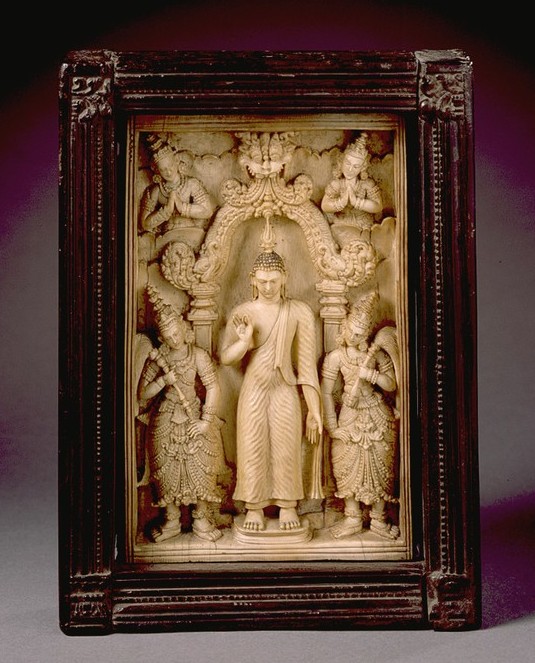
Ivory with paint, ebony frame, 18.7 x 14 x 3.2 centimeters.
Los Angeles County Museum of Art, purchased with funds provided
by Christian Humann. Photo © Museum Associates / LACMA
A second image is a deep relief carving in ivory of the standing Buddha and attendants in a bold ebony frame. The Buddha here is flanked by two attendants bearing fly whisks; above them, two celestial deities look down with hands in prayer. Framed by an elaborate archway, the Buddha stands with his right hand in a variation of the abhaya (fearlessness) mudra and his left hand open and facing downward in the varada (wish-granting) mudra. He also wears an almost diaphanous robe that clings to his solid form, and the simple, smooth lines of the fabric contrast with the intricate detailing that embellishes his attendants’ costumes. Most notable, perhaps, in this representation is the heaviness of his downward gaze. Though not in a posture of meditation, the Buddha appears deeply reflective, as if contemplating the weight of human suffering.
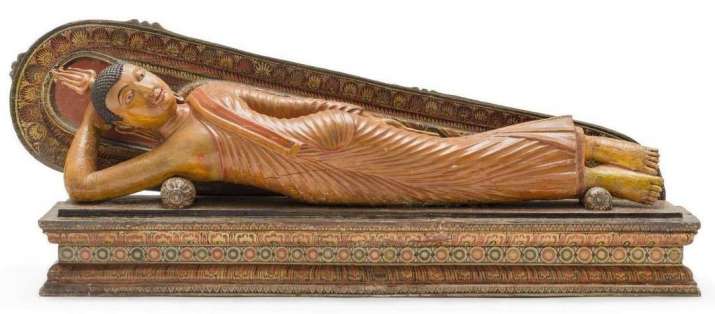
Wood with paint 36.8 × 98.9 × 16.8 centimeters.
Purchased with funds provided by Anna Bing Arnold.
Photo © Museum Associates / LACMA
A third Sri Lankan figure in the LACMA collection depicts the Buddha reclining on his right side with his head resting on his right hand. Carved out of wood and painted, the posture represents the final enlightenment or parinirvana of the Buddha, the moment when the historical Buddha shed his mortal human form and attained full nirvana, or spiritual release. This figure wears similarly thin, flowing robes but his body appears slender and light, almost floating, as if to suggest his imminent release from the material realm. His eyes are depicted wide open and looking into the distance and he wears a gentle smile, perhaps a sign that he is ready for his departure. His pedestal and the wooden halo-like mandorla behind him are delicately ornamented with painted flowers and lotus leaves, adding to a sense of lightness. His parinirvana was a moment to be celebrated and not mourned.
These three examples of 18th century Sri Lankan Buddhist sculpture date to a time when the Kandy kingdom was patronizing Buddhism and commissioned the construction of important Buddhist temples, such as the Sri Dalada Maligawa, the Temple of the Sacred Tooth Relic, in the city of Kandy near the royal palace. The images can be seen to represent the island’s continued devotion to the peaceful ideology of Buddhism at a time when European colonial powers were applying tremendous pressure on Sri Lanka before the British colonized the island in 1815. Today, as Sri Lanka struggles with the aftermath of horrific violence done in the name of religion, these beautiful figures of the Buddha, with their message of peace and release from suffering, are all the more poignant.
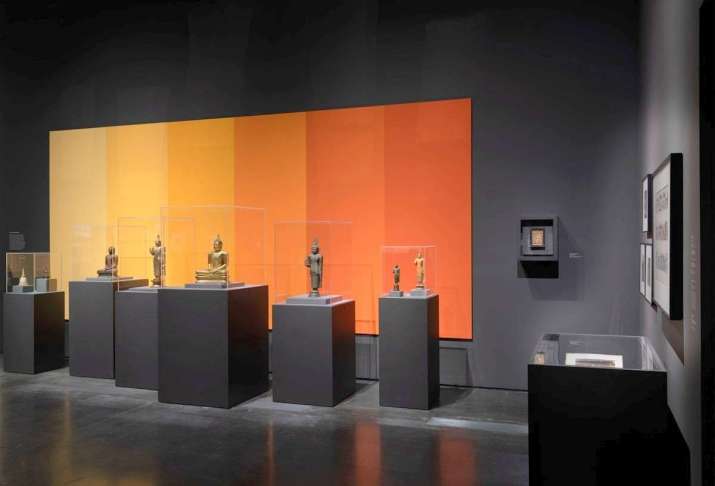
Los Angeles County Museum of Art. Photo © Museum Associates / LACMA
See more









